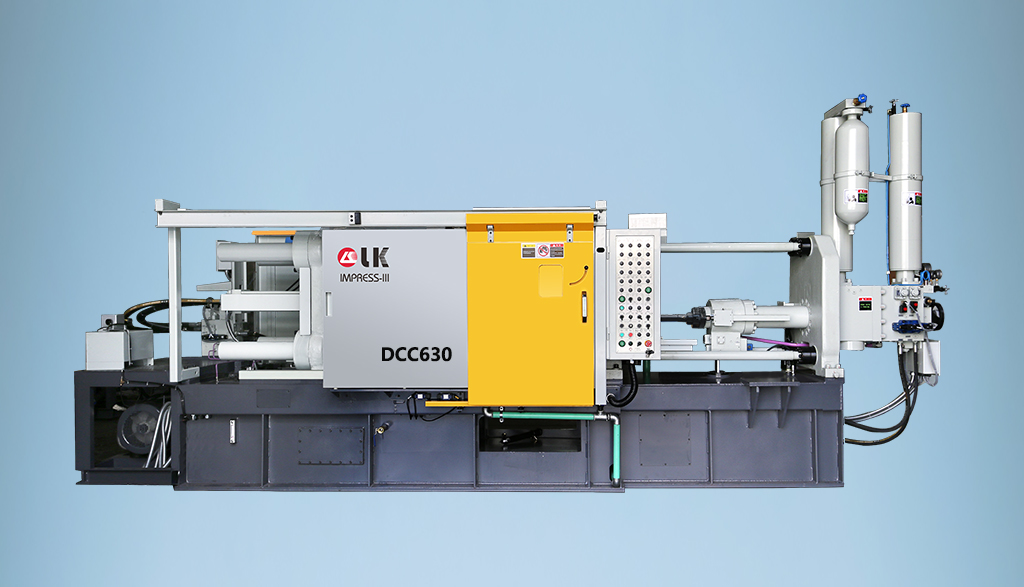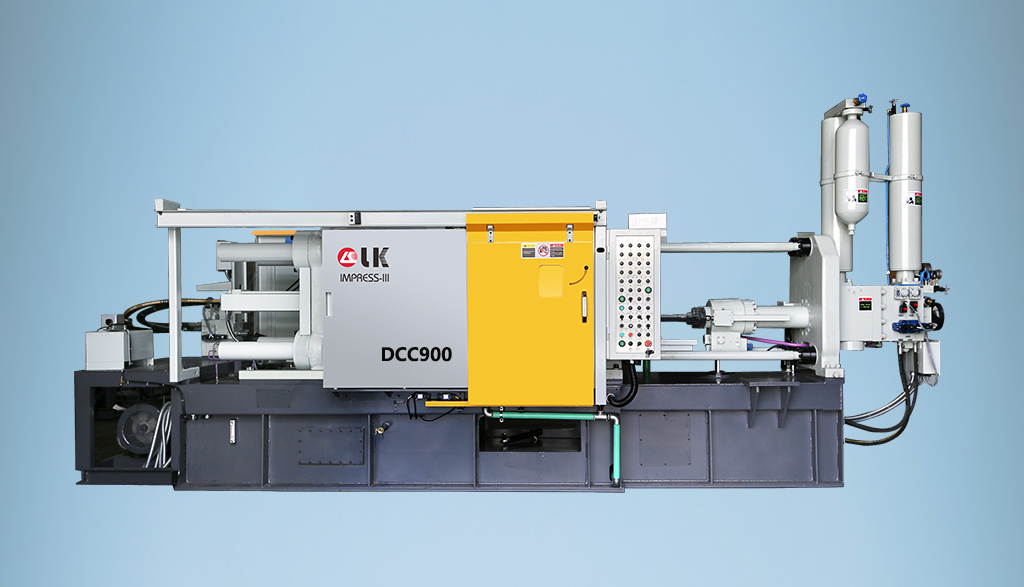What Components does a Die Casting Machine Consist of?
LK Die Casting Machine / 2024-07-03 14:39:24
By Cherry/ July 3rd, 2024
A die-casting machine is a device used to inject molten metal into a mold to produce parts of complex shapes.
Its main purpose is to efficiently produce metal products, which are widely used in the fields of automobiles, aviation, electronics, and home appliances.
This article will introduce the main components of the die-casting machine in detail to help readers better understand the structure and working principle of the die-casting machine.

1. Frame
The frame is the basic structure of the die-casting machine, supporting and fixing various components. The frame is usually made of high-strength steel with good rigidity and stability to ensure the stability of the machine under high-pressure operation.
2. Injection system
The injection system is the core part of the die-casting machine, which is used to inject molten metal into the mold. The injection system mostly consists of the following components:
Injection cylinder: The injection cylinder is a high-pressure hydraulic cylinder used to push the injection rod to inject the molten metal into the mold. The pressure and speed of the injection cylinder can be adjusted to meet different metal and mold requirements.
Injection rod: The injection rod squeezes the molten metal from the hopper into the mold through the push of the injection cylinder. The material of the injection rod is usually high-strength alloy steel to withstand high temperatures and high pressure.
Hopper: The hopper is used to store molten metal and deliver it to the injection rod. The hopper usually has a heat preservation function to keep the metal in a liquid state.
3. Mold clamping system
The mold clamping system is used to fix the mold on the die-casting machine and keep the mold closed during the injection process. The mold clamping system mainly consists of the following components:
Fixed template: The fixed template is used to install and fix one part of the mold and is connected to the frame.
Moving template: The moving template is used to install the other part of the mold and is opened and closed by the hydraulic system.
Hydraulic cylinder: The hydraulic cylinder drives the moving template to open and close the mold. The pressure and speed of the hydraulic cylinder can also be adjusted to ensure the tight closure and fast opening of the mold.
4. Control system
The control system is used to adjust and control the various operating parameters of the die-casting machine to ensure the normal operation of the machine. The control system mainly includes:
PLC controller: PLC (Programmable Logic Controller) is the core control unit of the die-casting machine, which is used to program and execute various operating instructions.
Touch screen: The touch screen is used to operate and monitor the die-casting machine and display various operating parameters and status information.
Sensor: The sensor is used to detect various parameters of the die-casting machine, such as pressure, temperature, and position, and feed the information back to the control system.
5. Cooling system
The cooling system is used to cool the mold and die-casting parts to accelerate solidification and improve production efficiency. The cooling system mainly includes:
Cooling water channel: A cooling water channel is provided in the mold for passing cooling water to reduce the temperature.
Cooling water pump: The cooling water pump is used to provide the pressure and flow of cooling water to ensure the cooling effect.
Heat exchanger: The heat exchanger is used to cool the circulating water and maintain the stability of the water temperature.
6. Hydraulic system
The hydraulic system provides power for the die-casting machine and drives the injection and clamping system. The hydraulic system mainly includes:
Hydraulic pump: The hydraulic pump is used to provide high-pressure hydraulic oil to drive the hydraulic cylinder.
Hydraulic valve: The hydraulic valve is used to control the flow and direction of the hydraulic oil to adjust the injection and clamping action.
Oil tank: The oil tank is used to store hydraulic oil and keep the oil clean through the filter.
7. Electrical system
The electrical system provides power support for the die-casting machine and ensures the normal operation of various electrical components. The electrical system mainly includes:
Power module: The power module is used to provide a stable power supply for the die-casting machine.
Motor: The motor is used to drive the hydraulic pump and other mechanical components.
Electrical control cabinet: Various electrical components and control circuits are set in the electrical control cabinet to manage and protect the electrical system.
8. Other auxiliary systems
In addition to the above main components, the die-casting machine also includes some auxiliary systems to improve the convenience and safety of operation. These auxiliary systems mainly include:
Lubrication system: The lubrication system is used to provide lubricating oil to each moving part to reduce wear and friction.
Safety system: The safety system is used to detect and prevent various faults and dangers, such as overpressure, overheating, and leakage.

Summary
The die-casting machine consists of multiple key components, which cooperate to complete the manufacturing process from molten metal injection to finished parts. By understanding the composition and structure of the die-casting machine in detail, readers can better grasp the working principle and operation skills of the die-casting machine.
I hope this article can provide practical reference information for readers who need to understand the die-casting machine.
Contact LK Egypt to learn more info about the die-casting machine.
LKAGENT OFFICE DCM
Address: Industry Zone, South of Port Said Kebly, Egypt
Phone: +86 13598704163
Mobile: +20 101 304 3317 +20 150 181 8310
Email: jack@zazmae.com ahmedmahmoud@zazmae.com
#die cast tooling
#trivalent chromate
#rapid prototype casting
#a360 aluminum
#aluminum caster
#aluminum prototype
#ideal 55 slider parts
#density of aluminum kg/mm3
#magnesium sheet metal
#parts of a metal gate
#subcontracting of screw machining for the luxury sector
#wall aluminum
#die casting tooling
#tooling for die casting
#density of aluminium in kg mm3
#clear chromate
#es casting metals
#gating material
#prototype aluminum
#sigma castings
#subcontracting of screw-machining for household appliances
#we squeeze to please machine
#aluminium gravity die casting
#aluminum part
#aluminum rapid prototyping
#nickel casting
#plunger tip for die casting machine
#rapid prototyping aluminium
OTHER CONTENT
-

2024-09-19 14:16:15 LK Cold Chamber Die Casting Machine DCC900 Locking Force: 9000KN Die Height: 400-1000mm Space Between Tie Bars: 930x930mm Shot Weight: 13.5Kg Casting Area Max:2250c㎡
More -

2024-09-19 14:11:06 LK Cold Chamber Die Casting Machine DCC280 Locking Force: 2800KN Die Height: 250-650mm Space Between Tie Bars: 560x560mm Shot Weight: 2.9Kg Casting Area Max:700c㎡
More -

2024-09-19 10:23:07 LK Cold Chamber Die Casting Machine DCC580 Locking Force: 5000KN Die Heigh: 350-850mm Space Between Tie Bars: 760x760mm Shot Weight: 6.9Kg Casting Area Max:1250c㎡
More -

2024-09-19 10:11:20 LK Cold Chamber Die Casting Machine DCC400 Locking Force: 4000KN Die Height: 300-700mm Space Between Tie Bars: 669x669mm Shot Weight: 4.7Kg Casting Area Max:1000c㎡
More

